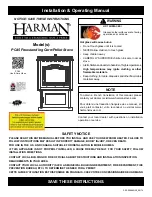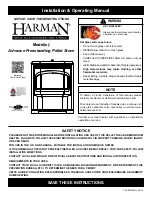
pass over the top and sides of the firechamber
opening and observe and record if the
smoke / combustion products are drawn into
the chimney or spill back into the room. Once
the smoke match / pen is extinguished, close
the appliance door.
4
Next, open all internal doors which
interconnect the room in which the stove
is installed to rooms where any extraction
fans are present and turn these on to the
maximum setting and allow to run for ten
minutes. Repeat the smoke match / pen
test above and observe and record if the
smoke / combustion products are drawn into
the chimney or spill back into the room.
5
If this spillage test fails, then progressively
open a window in the room where the stove
is installed. Again using a smoke match / pen
observe and report If the flue starts to draw
the smoke, then this will indicate that the
stove has not previously been provided with
sufficient air for the flue to function correctly
and therefore a permanently open air vent,
as specified in Document J or equivalent
regulations, may be necessary to correct
the problem. When the air supply has been
corrected then undertake the same test.
6
Fit an appropriate flue draught testing
device to the connecting flue pipe and re-
light the fire as previously. Repeat the test(s)
in points 1 – 4 above. Check that the flue
pressure meets the 12Pa minimum.
TEST 3
Extraction Test
This test requires a flue draught / temperature
gauge(s). This test is to ensure that Hi-Flame’s
recommended operational 12Pa flue draught
pressure for this stove is met. In some cases
spillage can still occur, so it is important to
carry out other essential smoke spillage tests.
1
Fit a flue pressure and flue gas temperature
testing device(s) to the flue of the appliance.
2
Close all external doors and windows, as
well as the internal doors to the room the
stove is located in and ensure all closable
ventilators (eg window trickle vents) are
closed and any devices that extract air from
the dwelling are turned off.
3
Light the appliance and ensure the optimum
operating temperature is reached (approx
240ºC).
4
Record the flue draught and the flue gas
temperature and confirm that these are within
the Hi-Flame’s recommended parameters.
5
Next, open all internal doors which
interconnect the room in which the stove is
installed to rooms where any extraction fans
are present and turn all of these on to the
maximum setting.
6
Run the extract system(s) for ten minutes,
and then record the flue draught and the flue
gas temperature. These should not be lower
than the previous readings obtained without
the extract system(s) running and should not
fall below Hi-Flame’s safe minimum 12Pa
recommendations.
7
Once the tests confirm the satisfactory
operation, remove the test device(s) and if
required seal any test point aperture in the
flue pipe.
Please note
if at any stage during
commissioning the flue draught reading taken
differs from the recommended minimum 12Pa,
then action should be taken to improve the
updraught before proceeding with further
testing.
Test results should be recorded on the
Commissioning Report on page 38 as
well as for any Hetas conformance.
37










































